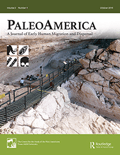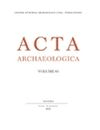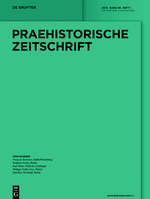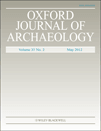
Bulletin de la Societe Prehistorique Francaise
Scope & Guideline
Decoding the Secrets of Prehistoric Societies
Introduction
Aims and Scopes
- Archaeology of Prehistoric Societies:
The journal extensively covers archaeological studies from various periods, including Paleolithic, Mesolithic, Neolithic, and Bronze Age, emphasizing the excavation and interpretation of sites. - Cultural Practices and Symbolism:
Research often explores the cultural artifacts, burial practices, and artistic expressions of prehistoric communities, revealing insights into their social structures and belief systems. - Technological and Economic Aspects:
There is a strong focus on the technological innovations and economic behaviors of prehistoric populations, including tool-making techniques and subsistence strategies. - Interdisciplinary Approaches:
The journal encourages interdisciplinary collaboration, integrating methods from anthropology, geology, and environmental sciences to enrich archaeological findings. - Regional Studies:
Particular attention is given to regional studies, with publications highlighting the specific archaeological contexts of various geographical areas, especially in France and surrounding regions.
Trending and Emerging
- Social Structures and Gender Studies:
There is an increasing emphasis on understanding social hierarchies and gender roles in prehistoric societies, moving beyond traditional narratives to include women's contributions and perspectives. - Interconnectivity and Cultural Exchange:
Recent publications are exploring themes of interconnectivity, trade, and cultural exchanges among prehistoric communities, indicating a growing interest in understanding the networks that shaped ancient societies. - Environmental Archaeology:
Studies focusing on the interactions between prehistoric societies and their environments are emerging, particularly in the context of climate change and resource management, reflecting a broader concern for ecological sustainability. - Digital Archaeology and Technological Innovations:
The integration of digital tools and methodologies in archaeological research is on the rise, with an emphasis on using technology for data visualization, analysis, and public engagement. - Cognitive Archaeology:
There is a growing interest in cognitive archaeology, exploring the mental and cultural frameworks of prehistoric peoples through their material culture, which is being increasingly reflected in recent studies.
Declining or Waning
- Late Bronze Age Studies:
Research on the Late Bronze Age has seen a decrease, with fewer publications exploring this period compared to earlier years. This may indicate a shift towards earlier prehistoric periods or a saturation of existing research. - Bioarchaeology and Human Remains:
While still present, the exploration of bioarchaeology and the analysis of human remains have become less frequent, possibly due to ethical considerations or a declining interest in this specific aspect of prehistoric research. - Technological Studies of Early Metals:
The focus on the technological studies surrounding early metallurgy and metal artifacts from the Bronze Age appears to be waning, suggesting a pivot towards more comprehensive studies of earlier lithic technologies.
Similar Journals

JOURNAL OF WORLD PREHISTORY
Illuminating the Path of Archaeological ScholarshipJOURNAL OF WORLD PREHISTORY, published by SPRINGER, stands as a premier platform for disseminating pioneering research and scholarship in the field of archaeology. Boasting a prestigious Q1 status in Archeology and a remarkable 97th percentile ranking in its category, this journal has made significant contributions to the understanding of global prehistory since its inception in 1987. It serves as an invaluable resource for researchers, professionals, and students alike, providing access to high-quality articles that explore diverse archaeological methodologies, theoretical frameworks, and case studies. Although it is not an open-access journal, its impact and relevance continue to resonate within the academic community, fostering critical discussions and advancing knowledge in this vital discipline. With publications converging from 2006 and set to continue until 2024, the JOURNAL OF WORLD PREHISTORY remains committed to advancing archaeological research and enhancing interdisciplinary collaboration.

PaleoAmerica
Uncovering the Mysteries of Prehistoric PeoplesPaleoAmerica, published by Routledge Journals, Taylor & Francis Ltd, is a leading academic journal dedicated to advancing the study of ancient peoples of the Americas. With a strong presence in the fields of archaeology, ecology, and paleontology, this journal holds Q1 rankings in its respective categories for 2023, reflecting its exceptional impact and relevance in academia. Covering a broad spectrum of topics related to human and ecological evolution from 2015 to 2024, PaleoAmerica serves as a vital resource for researchers, professionals, and students eager to explore pivotal findings and theories related to the prehistoric populations of North and South America. While the journal operates under a subscription model, its comprehensive scope and high-quality peer-reviewed articles make it indispensable for those engaging with the complex narratives of ancient American life.

ACTA ARCHAEOLOGICA
Unlocking the Secrets of Our AncestorsACTA ARCHAEOLOGICA is a highly regarded, peer-reviewed journal published by BRILL, focusing on the dynamic field of archaeology. With an ISSN of 0065-101X and an E-ISSN of 1600-0390, this journal disseminates innovative research, critical analyses, and comprehensive reviews that contribute to our understanding of human history, cultural heritage, and archaeological methodology. ACTA ARCHAEOLOGICA has excelled in its field, achieving a Q1 ranking in both the Arts and Humanities and Social Sciences categories for 2023, showcasing its impact and relevance in scholarly discourse. Though not currently open access, the journal caters to a diverse audience of researchers, professionals, and students, offering invaluable insights into archaeological studies from a global perspective. As it continues to foster academic dialogue, ACTA ARCHAEOLOGICA remains a cornerstone for those looking to deepen their knowledge and engage with cutting-edge archaeological research.

Praehistorische Zeitschrift
Championing Scholarly Excellence in Prehistoric ResearchPraehistorische Zeitschrift is a premier scholarly journal dedicated to the field of archaeology, published by WALTER DE GRUYTER GMBH in Germany. With a rich history dating back to 1909, the journal has evolved to encompass a wide range of topics pertaining to prehistory, offering vital insights into archaeological practices, theories, and discoveries. Recognized as a Q1 journal in both the Archaeology category of Arts and Humanities and the Social Sciences, it holds a prestigious position with Scopus rankings placing it in the top 20% of its field. Although it operates under a traditional publishing model without open access, its comprehensive articles are essential reading for researchers, professionals, and students alike who seek to deepen their understanding of prehistoric studies through rigorous academic contributions. The journal continues to publish significant research from 1993 to 2024 and beyond, making it an indispensable resource for anyone interested in the archaeological narrative of humanity.

Intersecciones en Antropologia
Navigating the intersections of culture and knowledge.Intersecciones en Antropologia, published by the Universidad Nacional del Centro de la Provincia de Buenos Aires (UNICEN), Facultad de Ciencias Sociales, is a premier open-access journal in the field of anthropology, having established its presence since 2010. With an impressive impact factor and currently holding the distinguished Q1 quartile ranking in anthropology for 2023, this journal has quickly become a vital resource for scholars and practitioners alike, offering a platform for innovative research and critical discussion. The journal aims to advance anthropological scholarship by encouraging the dissemination of diverse perspectives and stimulating dialogue across geographical and cultural boundaries. Its open-access model, adopted in 2017, ensures that valuable research findings are accessible to a global audience, fostering collaboration and engagement within the academic community and beyond. Located in the vibrant cultural context of Argentina, Intersecciones en Antropologia serves as a conduit for significant anthropological dialogues, making it an essential read for those dedicated to understanding and contributing to the evolving landscape of social sciences.

Time & Mind-The Journal of Archaeology Consciousness and Culture
Decoding Cultural Practices Through TimeTime & Mind - The Journal of Archaeology Consciousness and Culture, published by Routledge Journals, Taylor & Francis Ltd, stands at the intersection of archaeology and consciousness studies, revealing the intricate relationship between cultural practices and human cognition. With a robust ISSN of 1751-696X and an E-ISSN of 1751-6978, this esteemed journal plays a vital role in fostering interdisciplinary dialogue among scholars in the realms of anthropology and archaeology. Notably recognized for its rigorous academic standards, it achieved a commendable Q2 category ranking across various fields in 2023, including Anthropology and Archeology, alongside impressive Scopus rankings. As it continues to publish cutting-edge research from 2008 to 2024, this journal remains dedicated to exploring the nuances of human experience through the lens of archaeological evidence, making it an indispensable resource for researchers, professionals, and students alike seeking to deepen their understanding of the cultural dimensions of consciousness.

Oxford Journal of Archaeology
Uncovering the Past, Shaping the FutureOxford Journal of Archaeology is a prestigious peer-reviewed journal published by WILEY, dedicated to advancing the field of archaeology through innovative research and insightful discourse. Established in 1982, this journal has become a vital resource, showcasing high-impact studies that resonate within the arts and humanities, as well as interdisciplinary fields such as geography and planning. With an impressive Q1 ranking in both Archaeology and Arts & Humanities categories, and a Q2 ranking in Geography, Planning, and Development, the journal consistently maintains its reputation for excellence—evidenced by its ranking in the 81st percentile within the Scopus Arts and Humanities Archaeology category. The Oxford Journal of Archaeology not only provides scholars, professionals, and students with access to cutting-edge archaeological research but also encourages collaboration and dialogue among a diverse academic community. Although the journal does not currently offer Open Access, it remains a crucial platform for those seeking to expand their knowledge and impact in this dynamic field.

Mediterranean Archaeology & Archaeometry
Unveiling the Secrets of the Mediterranean PastMediterranean Archaeology & Archaeometry is a premier academic journal dedicated to advancing the fields of archaeology, anthropology, conservation, and history, published by UK Zhende Publishing Ltd. With its ISSN 1108-9628 and E-ISSN 2241-8121, this journal serves as a vital platform for scholars and practitioners to disseminate innovative research and findings related to the rich archaeological heritage of the Mediterranean region. It has gained remarkable recognition, achieving a Q2 ranking in anthropology and archaeology, and a Q1 classification in several categories including arts and humanities, conservation, and history as of 2023. Its impressive Scopus rankings underscore its impact, with a significant position in history (59/1760) and conservation (11/103) disciplines. Spanning years from 2008 to 2022, the journal invites open access contributions to foster collaboration and interdisciplinary dialogue among researchers, students, and professionals alike, making it an indispensable resource for those engaged in the exploration and preservation of historical narratives within the Mediterranean context.

Spal
Charting the Course of Archaeological Discovery.Spal is a distinguished academic journal dedicated to the fields of Archaeology and History, published by the University of Seville, Editorial. With an ISSN of 1133-4525 and an E-ISSN of 2255-3924, it has established a prominent reputation within the scholarly community, currently enjoying an impressive Q1 ranking in Archeology (Arts and Humanities) and History, alongside a Q2 ranking in Archeology for 2023. The journal serves as a critical platform for researchers, professionals, and students alike, promoting the dissemination of cutting-edge research and innovative methodologies in these vital disciplines. Spal's Scopus Ranks place it in the 84th percentile for Arts and Humanities - History and the 72nd for Archeology within the field, emphasizing its impact and relevance in contemporary scholarship. Although it operates under a traditional access model, its commitment to advancing knowledge and discourse in archaeological and historical studies remains unwavering. The journal's coverage spans from 2015 to 2024, positioning it well to contribute to ongoing academic conversations and foster collaborations within the global research community.

Studijne Zvesti Archeologickeho Ustavu Slovenskej Akademie Vied
Innovating methodologies for a deeper understanding of archaeology.Studijne Zvesti Archeologickeho Ustavu Slovenskej Akademie Vied is a leading journal in the field of archaeology, published by the SLOVENSKA AKAD VIED, ARCHEOLOGICKY USTAV, based in Nitra, Slovakia. This esteemed journal, with the ISSN 0560-2793, has established itself as a vital resource for scholars and researchers, reflecting significant academic contributions in both the arts and humanities as well as social sciences. With a 2023 Scopus ranking placing it in the second quartile (Q2) for archaeology, it showcases rigorous research and innovative methodologies, essential for advancing archaeological studies. While it is not an Open Access journal, it continues to offer valuable insights into archaeological findings, theoretical frameworks, and interdisciplinary approaches. The journal serves as a bridge, connecting local Slovak archaeology with international discourse, making it an indispensable tool for students, professionals, and academics striving for a deeper understanding of the archaeological heritage of Slovakia and beyond.